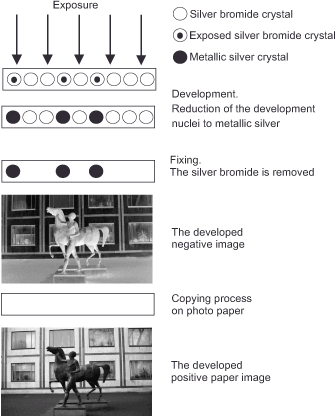You are here: Nature Science Photography – Image creation, Depth and Size – Photographic image creation
B/W negative film follows exactly the processing procedure described above. As we saw in the previous section, it reflects the motif’s brightness pattern in the opposite direction: particularly bright areas reflect a lot of light. Deep penetration of light into the layer reflects it onto adjacent silver halide crystals, thereby creating numerous development nuclei. There, the film becomes relatively opaque due to the high proportion of metallic silver, which impedes light from passing through. The positive process balances this distorted world by allowing only a small amount of light to penetrate the dark film area, resulting in minimal blackening of the photographic paper during the copying process, leaving it white. In contrast, the little light coming from dark parts of the motif produces only a few development nuclei, and the film is almost transparent in these places. Such a negative area lets almost all the light through during copying and exposes the photographic paper accordingly.

Next The reversal film
Main Image creation, Depth and Size
Previous The negative Film
If you found this post useful and want to support the continuation of my writing without intrusive advertising, please consider supporting. Your assistance goes towards helping make the content on this website even better. If you’d like to make a one-time ‘tip’ and buy me a coffee, I have a Ko-Fi page. Your support means a lot. Thank you!


 Since I started my first website in the year 2000, I’ve written and published ten books in the German language about photographing the amazing natural wonders of the American West, the details of our visual perception and its photography-related counterparts, and tried to shed some light on the immaterial concepts of quantum and chaos. Now all this material becomes freely accessible on this dedicated English website. I hope many of you find answers and inspiration there. My books are on
Since I started my first website in the year 2000, I’ve written and published ten books in the German language about photographing the amazing natural wonders of the American West, the details of our visual perception and its photography-related counterparts, and tried to shed some light on the immaterial concepts of quantum and chaos. Now all this material becomes freely accessible on this dedicated English website. I hope many of you find answers and inspiration there. My books are on